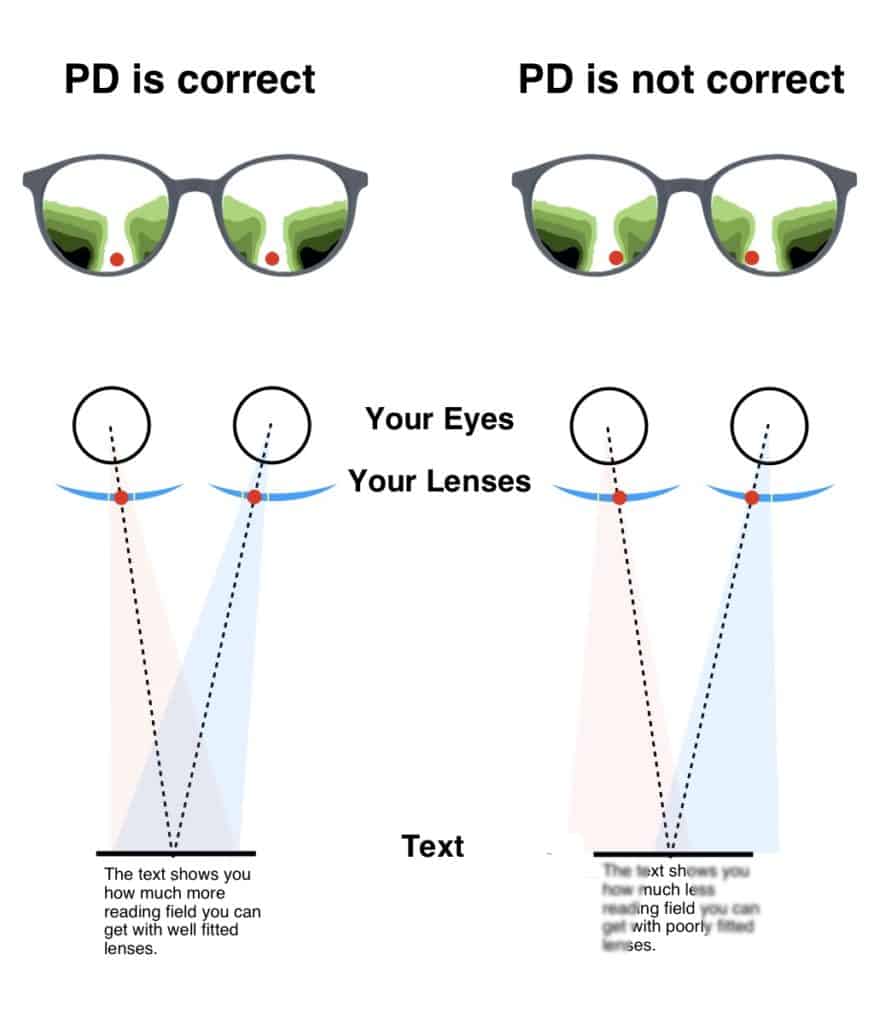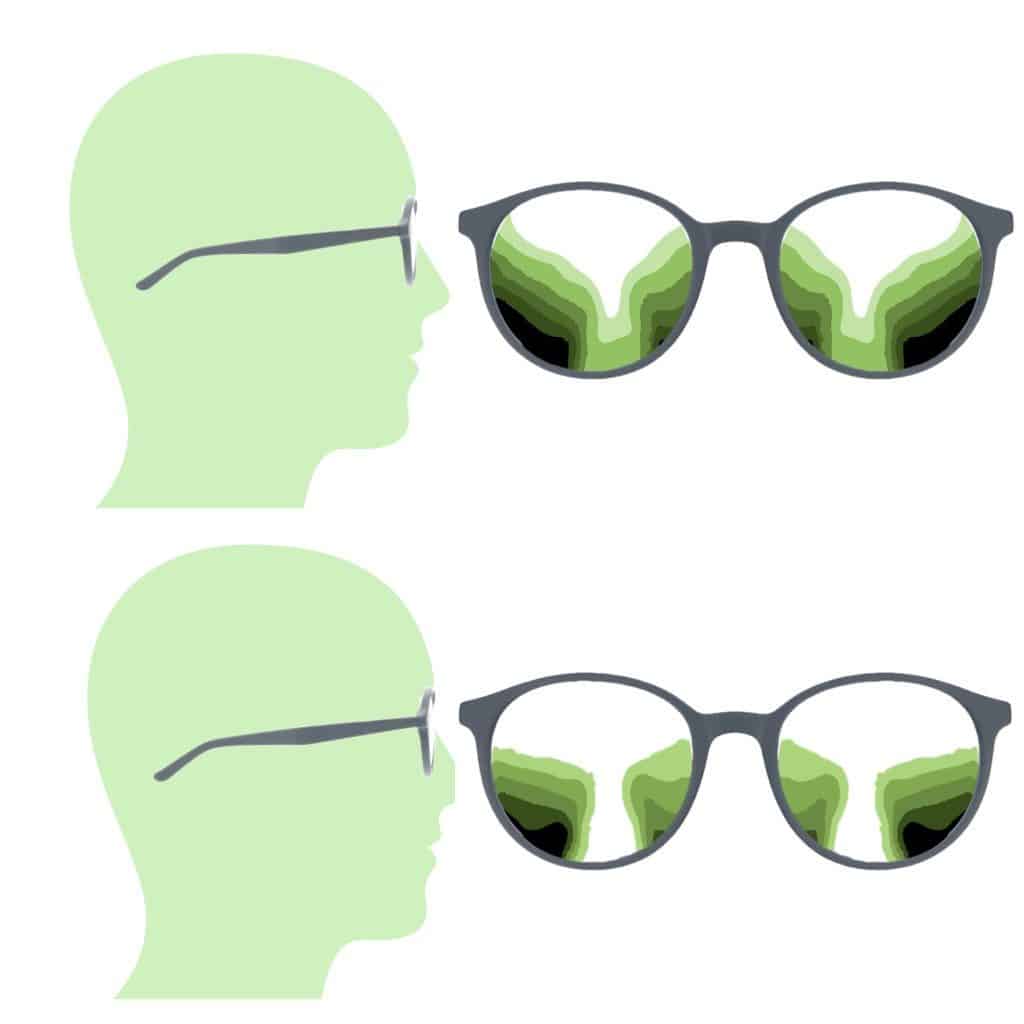The problems why you can´t read with your progressive lenses are caused by a false prescription or a false centered lens in front of your eyes. Or the combination of both.
In the following text, we will discuss the different ways why there may be difficulties reading at close range. Also, changes can be made in these places to bring you an improvement. There are two very big puzzle pieces in the production of your progressive lenses. These are the measurement of your eyes (aka refraction/prescription) and how the glasses sit in front of your eyes (centration of your progressive lenses).
A word in advance. You probably know the classic images that show what areas you should use when you are looking at a distance, at a distance from the PC, and while reading. The bright areas stand for optimal vision. On the other hand, the grey areas indicate blurred vision the more you look to the sides, the blurrier your view. These areas are heavily dependent on the following points and can change significantly.

- how high is your prescription (far- or shortsightedness and your astigmatism)
- how much support do you need to read (value of addition)
- how does the frame sit in your face
- how are the lenses centered in front of your eyes
But now let´s go into more detail here…
The Measurement of Your Prescription and How Measurement Errors Affect the Visible Areas for Reading at Close Range
When measuring your prescription, the utmost care is required. After all, even small measurement errors can quickly reduce the size of your clear areas of vision. In the accompanying pictures, you can see how the clear areas of vision are changed by an error in the prescription. To deal with all possible changes in the visual areas would blow up this article. We limit ourselves to an error in the measurement of astigmatism.
The first picture below shows the typical visible areas in progressive glasses. The pictures show the same lens type. However, the astigmatism was not accurately determined on the left side. The measured value is not correct by 0.25 D. You can see that the middle area is much narrower on the left side of the lens and the blurred areas are bigger compared to the right side. You can´t read as comfortably as you could without the described error.

In the second picture here below, you will again see the same type of progressive lens. However, the error in astigmatism is no longer just 0.25 dpt, but is 0.50 dpt. As a result, the field of view on the left side is extremely limited. Please keep in mind that these fields of vision are caused by an incorrect measurement.

Amazing, right? It is also important that both eyes play together optimally. These are important parts of a complete eye-test, which are simply dropped under the table when all should happen in five minutes. Time is really important to determine your glasses correctly. Because in many cases you look sharp, but whether you are relaxed at the same time, is a completely different question.
Your eyes can even compensate glasses with a false prescription and centration. It just costs concentration and leads to fatigue faster. To avoid such situations, there are special test methods, which tell us only after a certain time, whether your eyes are relaxed or strained to see clearly.
The Value of the Addition Is Decisive for Your Usable Areas of Vision While Reading
It is often abbreviated to Add on the glasses’ passport. The higher this Add value is, the narrower the usable field of view becomes in the intermediate and near range. This means you have to take your head with you, even more, when you look over a newspaper. We spoke at the beginning of the article about the visible areas that you have probably already seen.
These often do not have much to do with reality. Many customers are shocked. Even with bigger progressive lenses and perfect manufacturing, the usable areas are simply narrower than you would expect. Attached are pictures from Essilor with an Add value of + 2.00dpt. The picture shows an absolute high-end progressive lens on the right and you can see the dark blue areas. They stand for perfectly clear vision. As soon the color turns green you will experience a slight blur. The red and green colors show you the parts of the lenses where it gets really blurry.

If the addition is 2.25 or 2.50 D, the areas of reading will be narrower for you compared to the figure. The question is now. Is it possible for you to see as sharp as with Add 2.25dpt compared to an add of 2.00? Does the progressive lens have to be so powerful in this area? Our experience shows: in many cases no. Often wearers of progressive glasses also enjoy relaxed and sharp reading with a slightly weaker reading power.
There is even a big advantage with slightly less reading power. The advantage is the near range is less severely restricted. You have a little more space to look sharp in close range on the left and the right. However, this, of course, costs more time during the measurement.
How to Put Progressive Lenses in Front of Your Eyes so You Can Read Perfectly
The lenses must be aligned in such a way that you can look through the clear areas of the lenses at the same time with both eyes. If the field in a progressive lens is extremely narrow in the area for reading the lens is probably decentered.
Try this pro tip to clarify this point:
Look at something to read. Hold it right in the middle in front of you! Now, look at a word in the middle of the line. Close one eye at a time. How do you see the text? Try to notice the sharp and blurred areas in the text. Are the sharp area in the same places? Perfect, both eyes can see the same. Your progressive lenses are well adjusted.
But if that is not the case you will recognize bigger differences in the sharp areas and the blurred ones. For example, the right eye sees the word in the middle of the line sharp and the same amounts of words on the right and the left. Sounds good. Compared to that the left eye sees the word in the middle but no more words to the right. And the sharp field is decentered left. In this case, you need, to check back with your optical shop.
The area for reading in progressive glasses can be manufactured individually to not have these situations. What you can expect if your glasses when adjusted well are approximately 2-3 sharp columns of articles in a newspaper. (Depending on the Add value as described before)
The picture will clarify a lot here. Perfectly aligned reading areas result in a sharp image with the right and left eye simultaneously. In the picture, you see the red marked spots. Through them, you look at the nearby and ideally your eyes are centered within the clear field of vision. However, if you see through pretty close to the edge, only a small area will remain for you to look sharp at an article and problems with reading with your progressive lenses will come up.

Reading Is Just Not Seen Sharp, No Matter How You Hold Your Head, There Are Problems with the Progressive Glasses in Close Range
If the glasses in front of your face are very straight or inclined, the blur areas can change dramatically. In our example, you can see the difference between progressive glasses with the same inclination of the frame. The difference is clear to see in the resulting clear areas and comes only because one pair of lenses was not fitted to the angle it is sitting in. The glasses sit pretty straight in the face. For some progressive lenses this can be considered and for others not.
If you have glasses that do not take this into account, the optimum can only be achieved by adjusting the inclination of the frame (if the spectacle frame can be adjusted in such a way). If you look at the pictures, it is not surprising that looking through the upper progressive glasses brings massive problems in the reading area with it and blurriness must arise.

Do You Need a Short or Rather a Longer Progressive Lens? Find out What the Better Choice Is for You.
In the consultation around the progressive lenses, it is very important to adapt the close-range distance of the length of your arms to your everyday life. This means that we ophthalmologists/opticians need to understand which distances are important to you. Is it the iPad, the laptop or a pc and how long do you use those distances. In the picture below you can see pictures of a long progressive lens (top) and a short progressive lens (bottom).
For example, a long progressive lens allows you to see the laptop more easily because you simply have a wider field of view available. You just have a bit more room for eye movements to the right and left. In comparison, the short progressive lens and supports you earlier while you read in other words you do not need to look down as much to read.

For example, if you never use the laptop, a short progressive lens may be an advantage because you do not have to lower your eyes so much to see the newspaper or cell phone. And if you never use this distance because you never use a laptop, a short progressive lens could be totally fine. You can see in the pictures that the length of the progressive lens can have a very large influence on the size of the near zones of a progressive lens.
Even with a very large frame, which has a lot of height, a short progressive lens could be installed. That could make perfect sense if it fits you and your activities in everyday life. Consequently, they do not automatically have a long progressive lens for a large spectacle frame. I always like to talk to my customers about their daily activities after we measured everything and show them which possibilities are suitable for them.
I hope you found some good information here if currently, you are not satisfied with your progressives.
To me, it was a joy to write about one of my favorite topics.
Best regards
Michael Penczek
